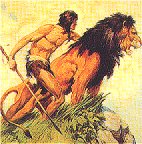
MINI-BIO More ERB Biographies featured on the ERBzine Site: Edgar Rice Burroughs Official Biographical Sketches I Edgar Rice Burroughs Official Biographical Sketches II ERB Online Bio Timeline |
      |

MINI-BIO More ERB Biographies featured on the ERBzine Site: Edgar Rice Burroughs Official Biographical Sketches I Edgar Rice Burroughs Official Biographical Sketches II ERB Online Bio Timeline |
      |
|
  |
    |
|
   |
"Tarzan of the Apes" appeared in the October 1912 issue of All-Story magazine. Burroughs received 700 dollars for the tale ~ and his career was off and running. Burroughs quickly discovered (probably to his secret delight, and certainly to the delight of countless readers) that he had many more tales to tell. There would be the inevitable Tarzan and Mars sequels but Burroughs' imagination needed even more worlds in which to roam, and so in the next few years he would try his hand at almost every type of story imaginable. Burroughs created the fabulous prehistoric inner world of Pellucidar (starting with At the Earth's Core), wrote other cave man fantasies (The Eternal Lover and The Land That Time Forgot), tales of courtly intrigue (The Mad King), a horror story (The Monster Men), novels of social realism (The Girl From Hollywood), Robinson Crusoe-type adventures (The Cave Girl), and one story that combined all of the above (The Mucker). Later still he would write westerns (The War Chief and others) and created yet another series, this one set on the planet Venus (starting with Pirates of Venus). But Tarzan would earn Burroughs his greatest success.
|
||
     |
   |
|
    |
    |
   |
|
   |




|
A rare collection of screen-size photographs https://www.erbzine.com/edgarriceburroughs/photos https://www.erbzine.com/edgarriceburroughs/photos/02.html |
More ERB Biographies featured
on the ERBzine Site:
ERB
Online Bio Timeline
Edgar
Rice Burroughs Official Biographical Sketches I
Edgar
Rice Burroughs Official Biographical Sketches II


.
ERB
Web Sites
From

The
Fantastic Worlds of Edgar Rice Burroughs